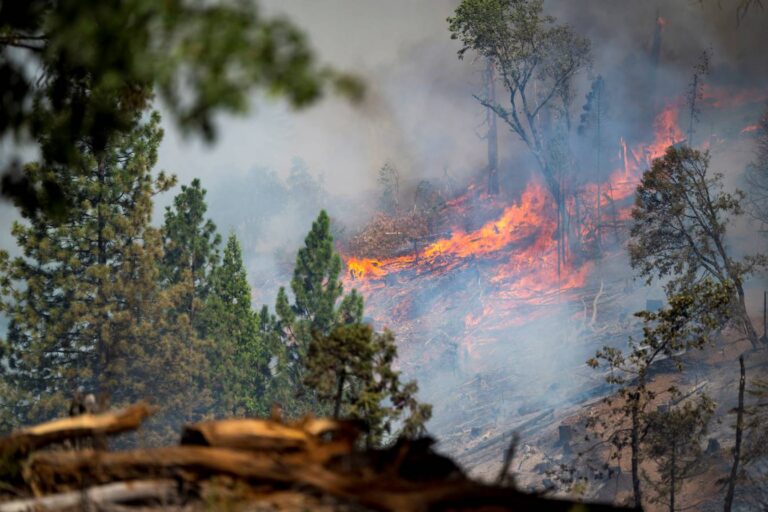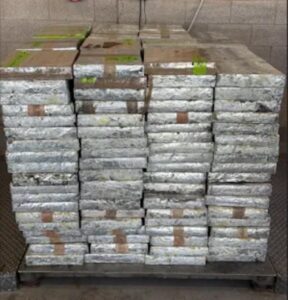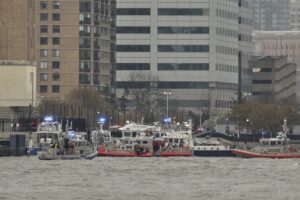FOREST RANCH, Calif. — Wildfires across the western United States and Canada put millions of people under air quality alerts on Sunday, July 28, as thousands of firefighters battled the flames, including the largest wildfire in California this year.
The so-called Park Fire had scorched more than 550 square miles of inland Northern California as of Sunday morning, darkening the sky with smoke and haze and contributing to poor air quality in a large swath of the Northwestern U.S. and western Canada.
Although the sprawling blaze was only 12% contained, cooler temperatures and increased humidity could help crews battle the fire, which has drawn comparisons to the 2018 Camp Fire that tore through the nearby community of Paradise, killing 85 people and torching 11,000 homes.
Paradise and several other Butte County communities were under an evacuation warning Sunday. However, Cal Fire operations section chief Jeremy Pierce had some good news for the area, saying around midday that the Park Fire’s southernmost front, which is closest to Paradise, was “looking really good,” with crews focusing on mopping up the area over the next three days. He also said they don’t expect it to move farther into Chico, a city of about 100,000 people just west of Paradise.
First responders initially focused on saving lives and property endangered by the Park Fire, but that has shifted to confronting the blaze head-on, Jay Tracy, a spokesperson at the Park Fire headquarters, told The Associated Press by phone Sunday. About 3,400 firefighters are battling the blaze, aided by numerous helicopters and air tankers, and Tracy said reinforcements would give much-needed rest to local firefighters, some of whom have been working nonstop since the fire started Wednesday.
“This fire is surprising a lot of people with its explosive growth,” he said. “It is kind of unparalleled.”
Although the area expects cooler-than-average temperatures through the middle of this week, that doesn’t mean “that fires that are existing will go away,” said Marc Chenard, a meteorologist at the National Weather Service’s Weather Prediction Center in College Park, Maryland.
The fire has destroyed at least 66 structures and damaged five others, Tracy said. Authorities initially believed 134 structures had been lost, based on drone footage, but they lowered the number after teams assessed the damage in-person.
“Unfortunately, that number will probably go up,” Tracy said. “Each day that number has potential to grow — our teams obviously don’t do damage inspections when there is active fire in an area.”
The Park Fire started Wednesday, when authorities say a man pushed a burning car into a gully in Chico and then fled. A Chico man accused of setting the fire was arrested Thursday and is due in court Monday.
The northern half of the fire still posed a challenge on Sunday, Pierce said, with crews using bulldozers and other equipment to build fire lines across rocky, difficult terrain and to try to stop the flames from spreading.
On Friday, California Gov. Gavin Newsom declared a state of emergency in several counties because of the Gold Complex and Park fires, according to the California Governor’s Office of Emergency Services.
“We are using every available tool to protect lives and property as our fire and emergency response teams work around the clock to combat these challenging fires,” Newsom said to residents. “Stay safe and remain alert for instructions from local authorities as dangerous fire weather conditions continue.”
The Park Fire was one of more than 100 blazes burning in the U.S. on Sunday, according to the National Interagency Fire Center (NIFC). Some were sparked by the weather, with climate change increasing the frequency of lightning strikes as the Western U.S. endures blistering heat and bone-dry conditions. A notice from the NIFC on Sunday morning noted that a total of 103 large, active wildfires had already burned more than 2 million acres.
Despite the improved fire weather in Northern California, conditions remained ripe for even more blazes to ignite, with the National Weather Service warning of “red flag” conditions on Sunday across wide swaths of Utah, Colorado and Wyoming, in addition to parts of California.
In Southern California, a fire in the Sequoia National Forest swept through the community of Havilah after burning more than 48 square miles in less than three days. The town of roughly 250 people had been under an evacuation order.
Fires were also burning across eastern Oregon and eastern Idaho, where officials were assessing damage from a group of blazes referred to as the Gwen Fire, which was estimated at 41 square miles in size as of Sunday.
The Trucker News Staff contributed to this report.
The Associated Press is an independent global news organization dedicated to factual reporting. Founded in 1846, AP today remains the most trusted source of fast, accurate, unbiased news in all formats and the essential provider of the technology and services vital to the news business. The Trucker Media Group is subscriber of The Associated Press has been granted the license to use this content on TheTrucker.com and The Trucker newspaper in accordance with its Content License Agreement with The Associated Press.







